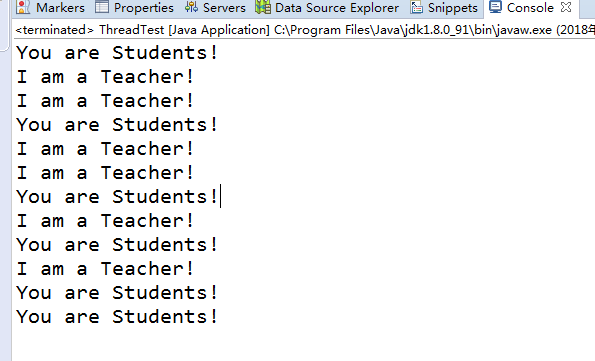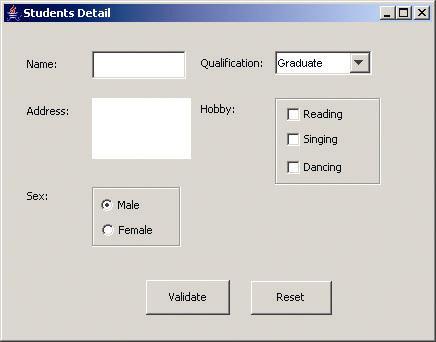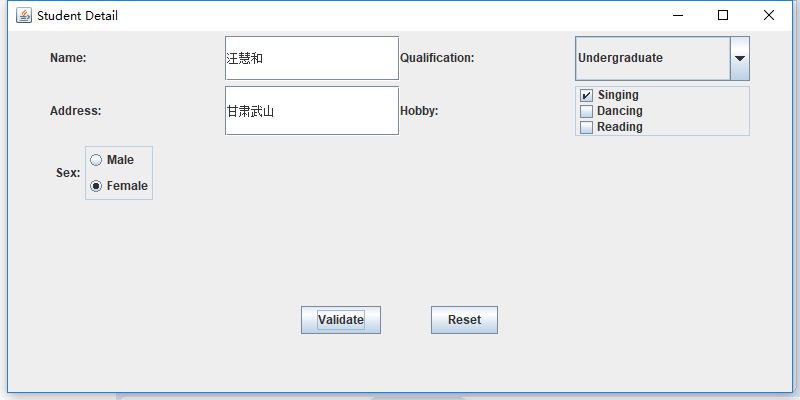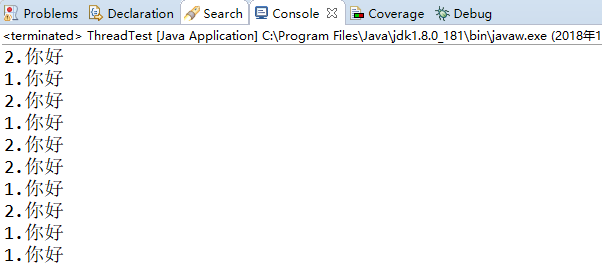201771010123汪慧和《面向对象程序设计Java》第十六周实验总结
一、理论部分
1、程序与进程的概念
‐程序是一段静态的代码,它是应用程序执行的蓝本。
‐进程是程序的一次动态执行,它对应了从代码加载、执行至执行完毕的一个完整过程。
‐操作系统为每个进程分配一段独立的内存空间和系统资源,包括:代码数据以及堆栈等资源。每 一个进程的内部数据和状态都是完全独立的。
‐多任务操作系统中,进程切换对CPU资源消耗较大。
2、多线程的概念
‐多线程是进程执行过程中产生的多条执行线索。
‐线程是比进程执行更小的单位。
‐线程不能独立存在,必须存在于进程中,同一进程的各线程间共享进程空间的数据。
‐每个线程有它自身的产生、存在和消亡的过程, 是一个动态的概念。
‐多线程意味着一个程序的多行语句可以看上去几 乎在同一时间内同时运行。
‐线程创建、销毁和切换的负荷远小于进程,又称为轻量级进程(lightweight process)。
3、Java实现多线程有两种途径:
‐创建Thread类的子类
‐在程序中定义实现Runnable接口的类
4、用Thread类子类创建线程
首先需从Thread类派生出一个子类,在该子类中重写run()方法。
class hand extends Thread
{
public void run()
{……}
}
5、用Thread类的子类创建多线程的关键性操作
–定义Thread类的子类并实现用户线程操作,即 run()方法的实现。
–在适当的时候启动线程。
由于Java只支持单重继承,用这种方法定义的类不可再继承其他父类。
6、用Runnable()接口实现线程
- 首先设计一个实现Runnable接口的类;
- 然后在类中根据需要重写run方法;
- 再创建该类对象,以此对象为参数建立Thread 类的对象;
- 调用Thread类对象的start方法启动线程,将 CPU执行权转交到run方法。
7、线程的终止
-当线程的run方法执行方法体中最后一条语句后,或者出现了在run方法中没有捕获的异常时,线程将终止,让出CPU使用权。
- 调用interrupt()方法也可终止线程。
void interrupt()
– 向一个线程发送一个中断请求,同时把这个线程的“interrupted”状态置为true。
– 若该线程处于 blocked 状态 ,会抛出 InterruptedException。
8、测试线程是否被中断的方法
Java提供了几个用于测试线程是否被中断的方法。
-static boolean interrupted()
– 检测当前线程是否已被中断 ,并重置状态 “interrupted”值为false。
-boolean isInterrupted()
– 检测当前线程是否已被中断 ,不改变状态 “interrupted”值 。
9、线程的状态
-利用各线程的状态变换,可以控制各个线程轮流使用CPU,体现多线程的并行性特征。
-线程有如下7种状态:
➢ New (新建)
➢ Runnable (可运行)
➢ Running(运行)
➢ Blocked (被阻塞)
➢ Waiting (等待)
➢ Timed waiting (计时等待)
➢ Terminated (被终止)
10、新创建线程
-new(新建)
线程对象刚刚创建,还没有启动,此时线程还处于不可运行状态。例如: Thread thread=new Thread(r); 此时线程thread处于新建状态,有了相应的内存空间以及其它资源。
11、可运行线程
- runnable(可运行状态)
➢ 此时线程已经启动,处于线程的run()方法之中。
➢ 此时的线程可能运行,也可能不运行,只要 CPU一空闲,马上就会运行。
➢ 调用线程的start()方法可使线程处于“可运行”状态。例如: thread.start();
12、被阻塞线程和等待线程
- blocked (被阻塞)
➢ 一个正在执行的线程因特殊原因,被暂停执行, 进入阻塞状态。
➢ 阻塞时线程不能进入队列排队,必须等到引起阻塞的原因消除,才可重新进入排队队列。
➢ 引起阻塞的原因很多,不同原因要用不同的方法解除。
-sleep(),wait()是两个常用引起线程阻塞的方法。
13、线程阻塞的三种情况
- 等待阻塞 -- 通过调用线程的wait()方法,让线程等待某工作的完成。
- 同步阻塞 -- 线程在获取synchronized同步锁失败(因为锁被其它线程所占用),它会进入同步阻塞状态。
-其他阻塞 -- 通过调用线程的sleep()或join() 或发出了I/O请求时,线程会进入到阻塞状态。当 sleep()状态超时、join()等待线程终止或者超 时、或者I/O处理完毕时,线程重新转入就绪状态。
14、被终止的线程
Terminated (被终止) 线程被终止的原因有二:
➢ 一是run()方法中最后一个语句执行完毕而自然死亡。
➢ 二是因为一个没有捕获的异常终止了run方法而意外死亡。
➢ 可以调用线程的 stop 方 法 杀 死 一 个 线 程(thread.stop();),但是,stop方法已过时, 不要在自己的代码中调用它。
15、多线程调度
-Java 的线程调度采用优先级策略:
➢ 优先级高的先执行,优先级低的后执行;
➢ 多线程系统会自动为每个线程分配一个优先级,缺省时,继承其父类的优先级;
➢ 任务紧急的线程,其优先级较高;
➢ 同优先级的线程按“先进先出”的队列原则;
16、Thread类有三个与线程优先级有关的静态量:
➢ MAX_PRIORITY:最大优先权,值为10;
➢ MIN_PRIORITY:最小优先权,值为1;
➢ NORM _PRIORITY:默认优先权,值为5。
二、实验部分
1、实验目的与要求
(1) 掌握线程概念;
(2) 掌握线程创建的两种技术;
(3) 理解和掌握线程的优先级属性及调度方法;
(4) 掌握线程同步的概念及实现技术;
2、实验内容和步骤
实验1:测试程序并进行代码注释。
测试程序1:
l 在elipse IDE中调试运行ThreadTest,结合程序运行结果理解程序;
l 掌握线程概念;
l 掌握用Thread的扩展类实现线程的方法;
l 利用Runnable接口改造程序,掌握用Runnable接口创建线程的方法。
|
class Lefthand extends Thread { public void run() { for(int i=0;i<=5;i++) { System.out.println("You are Students!"); try{ sleep(500); } catch(InterruptedException e) { System.out.println("Lefthand error.");} } } } class Righthand extends Thread { public void run() { for(int i=0;i<=5;i++) { System.out.println("I am a Teacher!"); try{ sleep(300); } catch(InterruptedException e) { System.out.println("Righthand error.");} } } } public class ThreadTest { static Lefthand left; static Righthand right; public static void main(String[] args) { left=new Lefthand(); right=new Righthand(); left.start(); right.start(); } } |
用Runnable接口改造程序的程序:
class Lefthand implements Runnable{
public void run()
{
for(int i=0;i<=5;i++)
{ System.out.println("You are Students!");
try{ Thread.sleep(500); }
catch(InterruptedException e)
{ System.out.println("Lefthand error.");}
}
}
}
class Righthand implements Runnable {
public void run()
{
for(int i=0;i<=5;i++)
{ System.out.println("I am a Teacher!");
try{ Thread.sleep(300); }
catch(InterruptedException e)
{ System.out.println("Righthand error.");}
}
}
}
public class ThreadTest
{
static Thread left;
static Thread right;
public static void main(String[] args)
{
Runnable lefthand = new Lefthand();
left=new Thread(lefthand);
left.start();
Runnable righthand = new Righthand();
right=new Thread(righthand);
right.start();
}
}
class Lefthand implements Runnable{
public void run()
{
for(int i=0;i<=5;i++)
{ System.out.println("You are Students!");
try{ Thread.sleep(500); }
catch(InterruptedException e)
{ System.out.println("Lefthand error.");}
}
}
}
class Righthand implements Runnable {
public void run()
{
for(int i=0;i<=5;i++)
{ System.out.println("I am a Teacher!");
try{ Thread.sleep(300); }
catch(InterruptedException e)
{ System.out.println("Righthand error.");}
}
}
}
public class ThreadTest
{
static Lefthand left;
static Righthand right;
public static void main(String[] args)
{
Runnable lefthand = new Lefthand();
Thread left=new Thread(lefthand);
left.start();
Runnable righthand = new Righthand();
Thread right=new Thread(righthand);
right.start();
}
}
实验结果如下图所示:

测试程序2:
l 在Elipse环境下调试教材625页程序14-1、14-2 、14-3,结合程序运行结果理解程序;
l 在Elipse环境下调试教材631页程序14-4,结合程序运行结果理解程序;
l 对比两个程序,理解线程的概念和用途;
l 掌握线程创建的两种技术。
package bounce; import java.awt.geom.*; /**
* 从长方形边缘上移动和弹跳的球
* @version 1.33 2007-05-17
* @author Cay Horstmann
*/
public class Ball
{
private static final int XSIZE = 15;
private static final int YSIZE = 15;
private double x = 0;
private double y = 0;
private double dx = 1;
private double dy = 1; /**
* 将球移动到下一个位置,如果球碰到其中一条边,则反向移动
*/
public void move(Rectangle2D bounds)
{
x += dx;
y += dy;
if (x < bounds.getMinX())
{
x = bounds.getMinX();
dx = -dx;
}
if (x + XSIZE >= bounds.getMaxX())
{
x = bounds.getMaxX() - XSIZE;
dx = -dx;
}
if (y < bounds.getMinY())
{
y = bounds.getMinY();
dy = -dy;
}
if (y + YSIZE >= bounds.getMaxY())
{
y = bounds.getMaxY() - YSIZE;
dy = -dy;
}
} /**
* 获取球在当前位置的形状。
*/
public Ellipse2D getShape()
{
return new Ellipse2D.Double(x, y, XSIZE, YSIZE);
}
}
package bounce; import java.awt.*;
import java.util.*;
import javax.swing.*; /**
* 画球的部件。
* @version 1.34 2012-01-26
* @author Cay Horstmann
*/
public class BallComponent extends JPanel
{
private static final int DEFAULT_WIDTH = 450;
private static final int DEFAULT_HEIGHT = 350; private java.util.List<Ball> balls = new ArrayList<>(); /**
* 向组件添加一个球。
* 要添加的球
*/
public void add(Ball b)
{
balls.add(b);
} public void paintComponent(Graphics g)
{
super.paintComponent(g); // 擦除背景
Graphics2D g2 = (Graphics2D) g;
for (Ball b : balls)
{
g2.fill(b.getShape());
}
} public Dimension getPreferredSize() { return new Dimension(DEFAULT_WIDTH, DEFAULT_HEIGHT); }
}
package bounce; import java.awt.*;
import java.awt.event.*;
import javax.swing.*; /**
* 显示一个动态弹跳球。
* @version 1.34 2015-06-21
* @author Cay Horstmann
*/
public class Bounce
{
public static void main(String[] args)
{
EventQueue.invokeLater(() -> {
JFrame frame = new BounceFrame();
frame.setDefaultCloseOperation(JFrame.EXIT_ON_CLOSE);
frame.setVisible(true);
});
}
} /**
* 带有球组件和按钮的框架。
*/
class BounceFrame extends JFrame
{
private BallComponent comp;
public static final int STEPS = 1000;
public static final int DELAY = 3; /**
* 使用组件构造框架,以显示弹跳球和开始和关闭按钮
*/
public BounceFrame()
{
setTitle("Bounce");
comp = new BallComponent();
add(comp, BorderLayout.CENTER);
JPanel buttonPanel = new JPanel();
addButton(buttonPanel, "Start", event -> addBall());
addButton(buttonPanel, "Close", event -> System.exit(0));
add(buttonPanel, BorderLayout.SOUTH);
pack();
} /**
* 将按钮添加到容器中。
* @param c容器
* @param 按钮标题
* @param 侦听器按钮的操作侦听器
*/
public void addButton(Container c, String title, ActionListener listener)
{
JButton button = new JButton(title);
c.add(button);
button.addActionListener(listener);
} /**
* 向面板中添加一个弹跳球,使其弹跳1000次。
*/
public void addBall()
{
try
{
Ball ball = new Ball();
comp.add(ball); for (int i = 1; i <= STEPS; i++)
{
ball.move(comp.getBounds());
comp.paint(comp.getGraphics());
Thread.sleep(DELAY);
}
}
catch (InterruptedException e)
{
}
}
}
实验结果如下图示:

说明:此程序的close按钮不起作用。
改进后的程序:
package bounceThread; import java.awt.geom.*; /**
球从A的边缘上移动和反弹的球矩形
* @version 1.33 2007-05-17
* @author Cay Horstmann
*/
public class Ball
{
private static final int XSIZE = 15;
private static final int YSIZE = 15;
private double x = 0;
private double y = 0;
private double dx = 1;
private double dy = 1; /**
Moves the ball to the next position, reversing direction
if it hits one of the edges
*/
public void move(Rectangle2D bounds)
{
x += dx;
y += dy;
if (x < bounds.getMinX())
{
x = bounds.getMinX();
dx = -dx;
}
if (x + XSIZE >= bounds.getMaxX())
{
x = bounds.getMaxX() - XSIZE;
dx = -dx;
}
if (y < bounds.getMinY())
{
y = bounds.getMinY();
dy = -dy;
}
if (y + YSIZE >= bounds.getMaxY())
{
y = bounds.getMaxY() - YSIZE;
dy = -dy;
}
} /**
获取球在当前位置的形状。
*/
public Ellipse2D getShape()
{
return new Ellipse2D.Double(x, y, XSIZE, YSIZE);
}
}
package bounceThread; import java.awt.*;
import java.util.*;
import javax.swing.*; /**
* 画球的部件。
* @version 1.34 2012-01-26
* @author Cay Horstmann
*/
public class BallComponent extends JComponent
{
private static final int DEFAULT_WIDTH = 450;
private static final int DEFAULT_HEIGHT = 350; private java.util.List<Ball> balls = new ArrayList<>(); /**
* 向面板中添加一个球。
* @param b the ball to add
*/
public void add(Ball b)
{
balls.add(b);
} public void paintComponent(Graphics g)
{
Graphics2D g2 = (Graphics2D) g;
for (Ball b : balls)
{
g2.fill(b.getShape());
}
} public Dimension getPreferredSize() { return new Dimension(DEFAULT_WIDTH, DEFAULT_HEIGHT); }
}
package bounceThread; import java.awt.*;
import java.awt.event.*; import javax.swing.*; /**
* 显示动画弹跳球。
* @version 1.34 2015-06-21
* @author Cay Horstmann
*/
public class BounceThread
{
public static void main(String[] args)
{
EventQueue.invokeLater(() -> {
JFrame frame = new BounceFrame();
frame.setTitle("BounceThread");
frame.setDefaultCloseOperation(JFrame.EXIT_ON_CLOSE);
frame.setVisible(true);
});
}
} /**
*带有面板和按钮的框架。
*/
class BounceFrame extends JFrame
{
private BallComponent comp;
public static final int STEPS = 1000;
public static final int DELAY = 5; /**
* 用显示弹跳球和的组件构造框架启动和关闭按钮
*/
public BounceFrame()
{
comp = new BallComponent();
add(comp, BorderLayout.CENTER);
JPanel buttonPanel = new JPanel();
addButton(buttonPanel, "Start", event -> addBall());
addButton(buttonPanel, "Close", event -> System.exit(0));
add(buttonPanel, BorderLayout.SOUTH);
pack();
} /**
* 将按钮添加到容器中。
* @param c容器
* @param 按钮标题
* @param 侦听器按钮的操作侦听器
*/
public void addButton(Container c, String title, ActionListener listener)
{
JButton button = new JButton(title);
c.add(button);
button.addActionListener(listener);
} /**
*在画布上添加一个弹跳球,并启动一根线使其弹跳
*/
public void addBall()
{
Ball ball = new Ball();
comp.add(ball);
Runnable r = () -> {
try
{
for (int i = 1; i <= STEPS; i++)
{
ball.move(comp.getBounds());
comp.repaint();
Thread.sleep(DELAY);
}
}
catch (InterruptedException e)
{
}
};
Thread t = new Thread(r);
t.start();
}
}
实验结果如下图所示:

说明:改进后的程序,close按钮可以起作用。
测试程序3:分析以下程序运行结果并理解程序。
|
class Race extends Thread { public static void main(String args[]) { Race[] runner=new Race[4]; for(int i=0;i<4;i++) runner[i]=new Race( ); for(int i=0;i<4;i++) runner[i].start( ); runner[1].setPriority(MIN_PRIORITY); runner[3].setPriority(MAX_PRIORITY);} public void run( ) { for(int i=0; i<1000000; i++); System.out.println(getName()+"线程的优先级是"+getPriority()+"已计算完毕!"); } } |
class Race extends Thread {
public static void main(String args[]) {
Race[] runner = new Race[4];
for (int i = 0; i < 4; i++)
runner[i] = new Race();
for (int i = 0; i < 4; i++)
runner[i].start();
runner[1].setPriority(MIN_PRIORITY);
runner[3].setPriority(MAX_PRIORITY);
}
public void run() {
for (int i = 0; i < 1000000; i++);// 执行空语句,用来延时,也可以换成sleep,sleep会释放CPU,会抛出异常
System.out.println(getName() + "线程的优先级是" + getPriority() + "已计算完毕!");
}
}
实验结果如下图所示:

测试程序4
l 教材642页程序模拟一个有若干账户的银行,随机地生成在这些账户之间转移钱款的交易。每一个账户有一个线程。在每一笔交易中,会从线程所服务的账户中随机转移一定数目的钱款到另一个随机账户。
l 在Elipse环境下调试教材642页程序14-5、14-6,结合程序运行结果理解程序;
package unsynch; import java.util.*; /**
* 有许多银行账户的银行。
* @version 1.30 2004-08-01
* @author Cay Horstmann
*/
public class Bank
{
private final double[] accounts; /**
*构建了银行。
* @param n账户数量
* @param 每个帐户的初始余额
*/
public Bank(int n, double initialBalance)
{
accounts = new double[n];
Arrays.fill(accounts, initialBalance);
} /**
* 把钱从一个账户转到另一个账户。
* @param 从账户转出
* @param 到账转到
* @param 转帐金额
*/
public void transfer(int from, int to, double amount)
{
if (accounts[from] < amount) return;
System.out.print(Thread.currentThread());
accounts[from] -= amount;
System.out.printf(" %10.2f from %d to %d", amount, from, to);
accounts[to] += amount;
System.out.printf(" Total Balance: %10.2f%n", getTotalBalance());
} /**
* 获取所有帐户余额的总和。
* @return 总平衡
*/
public double getTotalBalance()
{
double sum = 0; for (double a : accounts)
sum += a; return sum;
} /**
* 获取银行中的帐户编号。
* @return 账户数量
*/
public int size()
{
return accounts.length;
}
}
package unsynch; /**
* 当多个线程访问一个数据结构时,这个程序显示数据损坏。
* @version 1.31 2015-06-21
* @author Cay Horstmann
*/
public class UnsynchBankTest
{
public static final int NACCOUNTS = 100;
public static final double INITIAL_BALANCE = 1000;
public static final double MAX_AMOUNT = 1000;
public static final int DELAY = 10; public static void main(String[] args)
{
Bank bank = new Bank(NACCOUNTS, INITIAL_BALANCE);
for (int i = 0; i < NACCOUNTS; i++)
{
int fromAccount = i;
Runnable r = () -> {
try
{
while (true)
{
int toAccount = (int) (bank.size() * Math.random());
double amount = MAX_AMOUNT * Math.random();
bank.transfer(fromAccount, toAccount, amount);
Thread.sleep((int) (DELAY * Math.random()));
}
}
catch (InterruptedException e)
{
}
};
Thread t = new Thread(r);
t.start();
}
}
}
实验结果如下图所示:
 综合编程练习
综合编程练习
编程练习1
1. 设计一个用户信息采集程序,要求如下:
(1) 用户信息输入界面如下图所示:

(2) 用户点击提交按钮时,用户输入信息显示控制台界面;
(3) 用户点击重置按钮后,清空用户已输入信息;
(4) 点击窗口关闭,程序退出。
package test1;
import java.awt.EventQueue;
import javax.swing.JFrame;
public class Mian {
public static void main(String[] args) {
EventQueue.invokeLater(() -> {
DemoJFrame page = new DemoJFrame();
});
}
}
package test1;
import java.awt.Dimension;
import java.awt.Toolkit;
import java.awt.Window; public class WinCenter {
public static void center(Window win){
Toolkit tkit = Toolkit.getDefaultToolkit();//获取默认工具包
Dimension sSize = tkit.getScreenSize();//获取屏幕的大小
Dimension wSize = win.getSize();
if(wSize.height > sSize.height){
wSize.height = sSize.height;
}
if(wSize.width > sSize.width){
wSize.width = sSize.width;
}
win.setLocation((sSize.width - wSize.width)/ 2, (sSize.height - wSize.height)/ 2);//将组件移到新的位置
}
}
package test1;
import java.awt.Color;
import java.awt.Dimension;
import java.awt.FlowLayout;
import java.awt.GridLayout;
import java.awt.LayoutManager;
import java.awt.Panel;
import java.awt.event.ActionEvent;
import java.awt.event.ActionListener;
import java.io.BufferedReader;
import java.io.File;
import java.io.FileInputStream;
import java.io.IOException;
import java.io.InputStreamReader;
import java.util.ArrayList;
import java.util.Timer;
import java.util.TimerTask; import javax.swing.BorderFactory;
import javax.swing.ButtonGroup;
import javax.swing.ButtonModel;
import javax.swing.JButton;
import javax.swing.JCheckBox;
import javax.swing.JComboBox;
import javax.swing.JFrame;
import javax.swing.JLabel;
import javax.swing.JPanel;
import javax.swing.JRadioButton;
import javax.swing.JTextField; public class DemoJFrame extends JFrame {
private JPanel jPanel1;
private JPanel jPanel2;
private JPanel jPanel3;
private JPanel jPanel4;
private JTextField fieldname;
private JComboBox comboBox;
private JTextField fieldadress;
private ButtonGroup bg;
private JRadioButton nan;
private JRadioButton nv;
private JCheckBox sing;
private JCheckBox dance;
private JCheckBox draw; public DemoJFrame() {
// 设置窗口大小
this.setSize(800, 400);
// 设置可见性
this.setVisible(true);
// 设置标题
this.setTitle("Student Detail");
// 设置关闭操作
this.setDefaultCloseOperation(EXIT_ON_CLOSE);
// 设置窗口居中
WinCenter.center(this);
// 创建四个面板对象
jPanel1 = new JPanel();
setJPanel1(jPanel1);
jPanel2 = new JPanel();
setJPanel2(jPanel2);
jPanel3 = new JPanel();
setJPanel3(jPanel3);
jPanel4 = new JPanel();
setJPanel4(jPanel4);
// 设置容器为流式布局
FlowLayout flowLayout = new FlowLayout();
this.setLayout(flowLayout);
// 将四个面板添加到容器中
this.add(jPanel1);
this.add(jPanel2);
this.add(jPanel3);
this.add(jPanel4); } /*
* 设置面板一
*/
private void setJPanel1(JPanel jPanel) {
jPanel.setPreferredSize(new Dimension(700, 45));//设置此组件的首选大小
// 给面板的布局设置为网格布局 一行4列
jPanel.setLayout(new GridLayout(1, 4));
JLabel name = new JLabel("Name:");
name.setSize(100, 50);
fieldname = new JTextField("");
fieldname.setSize(80, 20);
JLabel study = new JLabel("Qualification:");
comboBox = new JComboBox();
comboBox.addItem("Graduate");
comboBox.addItem("senior");
comboBox.addItem("Undergraduate");
jPanel.add(name);
jPanel.add(fieldname);
jPanel.add(study);
jPanel.add(comboBox); } /*
* 设置面板二
*/
private void setJPanel2(JPanel jPanel) {
jPanel.setPreferredSize(new Dimension(700, 50));
// 给面板的布局设置为网格布局 一行4列
jPanel.setLayout(new GridLayout(1, 4));
JLabel name = new JLabel("Address:");
fieldadress = new JTextField();
fieldadress.setPreferredSize(new Dimension(150, 50));
JLabel study = new JLabel("Hobby:");
JPanel selectBox = new JPanel();
selectBox.setBorder(BorderFactory.createTitledBorder(""));
selectBox.setLayout(new GridLayout(3, 1));
sing = new JCheckBox("Singing");
dance = new JCheckBox("Dancing");
draw = new JCheckBox("Reading");
selectBox.add(sing);
selectBox.add(dance);
selectBox.add(draw);
jPanel.add(name);
jPanel.add(fieldadress);
jPanel.add(study);
jPanel.add(selectBox);
} /*
* 设置面板三
*/
private void setJPanel3(JPanel jPanel) {
jPanel.setPreferredSize(new Dimension(700, 150));
FlowLayout flowLayout = new FlowLayout(FlowLayout.LEFT);
jPanel.setLayout(flowLayout);
JLabel sex = new JLabel("Sex:");
JPanel selectBox = new JPanel();
selectBox.setBorder(BorderFactory.createTitledBorder(""));
selectBox.setLayout(new GridLayout(2, 1));
bg = new ButtonGroup();
nan = new JRadioButton("Male");
nv = new JRadioButton("Female");
bg.add(nan);
bg.add(nv);
selectBox.add(nan);
selectBox.add(nv);
jPanel.add(sex);
jPanel.add(selectBox); } /*
* 设置面板四
*/
private void setJPanel4(JPanel jPanel) {
// TODO 自动生成的方法存根
jPanel.setPreferredSize(new Dimension(700, 150));
FlowLayout flowLayout = new FlowLayout(FlowLayout.CENTER, 50, 10);
jPanel.setLayout(flowLayout);
jPanel.setLayout(flowLayout);
JButton sublite = new JButton("Validate");
JButton reset = new JButton("Reset");
sublite.addActionListener((e) -> valiData());
reset.addActionListener((e) -> Reset());
jPanel.add(sublite);
jPanel.add(reset);
} /*
* 提交数据
*/
private void valiData() {
// 拿到数据
String name = fieldname.getText().toString().trim();
String xueli = comboBox.getSelectedItem().toString().trim();
String address = fieldadress.getText().toString().trim();
System.out.println(name);
System.out.println(xueli);
String hobbystring="";
if (sing.isSelected()) {
hobbystring+="Singing ";
}
if (dance.isSelected()) {
hobbystring+="Dancing ";
}
if (draw.isSelected()) {
hobbystring+="Reading ";
}
System.out.println(address);
if (nan.isSelected()) {
System.out.println("Male");
}
if (nv.isSelected()) {
System.out.println("Female");
}
System.out.println(hobbystring);
} /*
* 重置
*/
private void Reset() {
fieldadress.setText(null);
fieldname.setText(null);
comboBox.setSelectedIndex(0);
sing.setSelected(false);
dance.setSelected(false);
draw.setSelected(false);
bg.clearSelection();
}
}
实验结果如下图所示:


2.创建两个线程,每个线程按顺序输出5次“你好”,每个“你好”要标明来自哪个线程及其顺序号。
package test2;
class Lefthand extends Thread { public void run() { for(int i=0;i<=4;i++) { System.out.println("1.你好"); try{ sleep(500); } catch(InterruptedException e) { System.out.println("Lefthand error.");} } } } class Righthand extends Thread { public void run() { for(int i=0;i<=4;i++) { System.out.println("2.你好"); try{ sleep(300); } catch(InterruptedException e) { System.out.println("Righthand error.");} } } } public class ThreadTest { static Lefthand left; static Righthand right; public static void main(String[] args) { left=new Lefthand(); right=new Righthand(); left.start(); right.start(); } }
实验结果如下图所示:

3.完善实验十五 GUI综合编程练习程序。
实验一
import java.awt.*;
import javax.swing.*; public class CardTest {
public static void main(String[] args) {
EventQueue.invokeLater(() -> {
JFrame frame = new Main();
frame.setTitle("身份证");
frame.setDefaultCloseOperation(JFrame.EXIT_ON_CLOSE);
frame.setVisible(true);
});
}
}
public class Card implements Comparable<Card> {
private String name;
private String id;
private String sex;
private int age;
private String area;
public String getName() {
return name;
}
public void setName(String name) {
this.name = name;
}
public String getId() {
return id;
}
public void setId(String id) {
this.id = id;
}
public String getSex() {
return sex;
}
public void setSex(String sex) {
this.sex = sex;
}
public int getAge() {
return age;
}
public void setAge(int age) {
this.age = age;
}
public String getArea() {
return area;
}
public void setArea(String area) {
this.area = area;
}
public int compareTo(Card c) {
return this.name.compareTo(c.getName());
}
public String toString() {
return name + "\t" + id + "\t" + sex + "\t" + age + "\t" + area + "\n";
}
}
import java.awt.*;
import java.awt.event.*;
import java.io.*;
import java.util.*;
import javax.swing.*; public class Main extends JFrame {
private static ArrayList<Card> cardlist;
private static ArrayList<Card> list;
private JPanel panel;
private JPanel Panel1;
private static final int DEFAULT_WITH = 600;
private static final int DEFAULT_HEIGHT = 300; public Main() {
cardlist = new ArrayList<>();
Scanner scanner = new Scanner(System.in);
File file = new File("E:\\身份证号.txt");
try {
FileInputStream fis = new FileInputStream(file);
BufferedReader in = new BufferedReader(new InputStreamReader(fis));
String temp = null; while ((temp = in.readLine()) != null) {
Scanner linescanner = new Scanner(temp);
linescanner.useDelimiter(" ");
String name = linescanner.next();
String id = linescanner.next();
String sex = linescanner.next();
String age = linescanner.next();
String area = linescanner.nextLine(); Card card = new Card();
card.setName(name);
card.setId(id);
card.setSex(sex);
int a = Integer.parseInt(age);
card.setAge(a);
card.setArea(area); cardlist.add(card);
} } catch (FileNotFoundException e) {
// TODO Auto-generated catch block
System.out.println("信息文件找不到");
e.printStackTrace();
} catch (IOException e) {
// TODO Auto-generated catch block
System.out.println("信息文件读取错误");
e.printStackTrace();
}
panel = new JPanel();
panel.setLayout(new BorderLayout());
JTextArea jt = new JTextArea();
panel.add(jt);
add(panel, BorderLayout.NORTH);
Panel1 = new JPanel();
Panel1.setLayout(new GridLayout(1, 9));
JButton jButton = new JButton("字典排序");
JButton jButton1 = new JButton("年龄最大和年龄最小");
JLabel lab = new JLabel("寻找老乡:", Label.LEFT);
JTextField jt1 = new JTextField();
JLabel lab1 = new JLabel("寻找年龄相近的人:", Label.LEFT);
JTextField jt2 = new JTextField();
JLabel lab2 = new JLabel("输入你的身份证号码:", Label.LEFT);
JTextField jt3 = new JTextField();
JButton jButton2 = new JButton("退出"); jButton.addActionListener(new ActionListener() { @Override
public void actionPerformed(ActionEvent e) {
// TODO 自动生成的方法存根
Collections.sort(cardlist);
jt.setText(cardlist.toString()); }
}); jButton1.addActionListener(new ActionListener() { @Override
public void actionPerformed(ActionEvent e) {
// TODO 自动生成的方法存根
int max = 0, min = 100;
int j, k1 = 0, k2 = 0;
for (int i = 1; i < cardlist.size(); i++) {
j = cardlist.get(i).getAge();
if (j > max) {
max = j;
k1 = i;
}
if (j < min) {
min = j;
k2 = i;
}
}
jt.setText("年龄最大:" + cardlist.get(k1) + "年龄最小:" + cardlist.get(k2));
}
}); jButton2.addActionListener(new ActionListener() {
public void actionPerformed(ActionEvent e) {
dispose();
System.exit(0);
}
});
jt1.addActionListener(new ActionListener() {
public void actionPerformed(ActionEvent e) {
String find = jt1.getText();
String text = "";
String place = find.substring(0, 3);
for (int i = 0; i < cardlist.size(); i++) {
if (cardlist.get(i).getArea().substring(1, 4).equals(place)) {
text += "\n" + cardlist.get(i);
jt.setText("老乡:" + text);
}
}
}
});
jt2.addActionListener(new ActionListener() {
public void actionPerformed(ActionEvent e) {
String yourage = jt2.getText();
int a = Integer.parseInt(yourage);
int near = agenear(a);
jt.setText("年龄相近:" + cardlist.get(near));
}
});
jt3.addKeyListener(new KeyAdapter() {
public void keyTyped(KeyEvent e) {
// TODO 自动生成的方法存根
list = new ArrayList<>();
Collections.sort(cardlist);
String key = jt3.getText();
for (int i = 1; i < cardlist.size(); i++) {
if (cardlist.get(i).getId().contains(key)) {
list.add(cardlist.get(i));
jt.setText("你可能是:\n" + list);
}
}
}
});
Panel1.add(jButton);
Panel1.add(jButton1);
Panel1.add(lab);
Panel1.add(jt1);
Panel1.add(lab1);
Panel1.add(jt2);
Panel1.add(lab2);
Panel1.add(jt3);
Panel1.add(jButton2);
add(Panel1, BorderLayout.SOUTH);
setSize(DEFAULT_WITH, DEFAULT_HEIGHT);
} public static int agenear(int age) {
int j = 0, min = 100, value = 0, k = 0;
for (int i = 0; i < cardlist.size(); i++) {
value = cardlist.get(i).getAge() - age;
if (value < 0)
value = -value;
if (value < min) {
min = value;
k = i;
}
}
return k;
}
}
实验二:
import java.awt.*;
import java.awt.event.*;
import java.io.*;
import java.util.*;
import javax.swing.*; public class Demo extends JFrame {
int i = 0, i1 = 0, k = 0, sum = 0;
private PrintWriter out = null;
private String[] c1 = new String[10];
private String[] c2 = new String[10]; public Demo() {
JPanel panel = new JPanel();
panel.setLayout(new GridLayout(1, 3));
JTextArea jt1 = new JTextArea();
JTextField jt2 = new JTextField();
JTextArea jt3 = new JTextArea();
panel.add(jt1);
panel.add(jt2);
panel.add(jt3);
add(panel, BorderLayout.NORTH); JPanel panel1 = new JPanel();
panel1.setLayout(new GridLayout(1, 2));
Button button1 = new Button("生成题目"); Button button2 = new Button("生成文件");
panel1.add(button1);
panel1.add(button2); add(panel1, BorderLayout.SOUTH);
setSize(600, 300);
button1.addActionListener(new ActionListener() { @Override
public void actionPerformed(ActionEvent e) {
// TODO 自动生成的方法存根
jt2.setText(null);
jt3.setText(null);
if (i < 10) {
int a = (int) (Math.random() * 100);
int b = (int) (Math.random() * 100);
int m = (int) Math.round(Math.random() * 3);
switch (m) {
case 0:
while (b == 0 || a % b != 0) {
b = (int) Math.round(Math.random() * 100);
a = (int) Math.round(Math.random() * 100);
}
jt1.setText(i + 1 + ": " + a + "/" + b + "=");
c1[i] = jt1.getText();
k = a / b;
i++;
break;
case 1:
jt1.setText(i + 1 + ": " + a + "*" + b + "=");
c1[i] = jt1.getText();
k = a * b;
i++;
break;
case 2:
jt1.setText(i + 1 + ": " + a + "+" + b + "=");
c1[i] = jt1.getText();
k = a + b;
i++;
break;
case 3:
while (a < b) {
int x = a;
a = b;
b = x;
}
jt1.setText(i + 1 + ": " + a + "-" + b + "=");
c1[i] = jt1.getText();
k = a - b;
i++;
break;
}
}
}
});
jt2.addActionListener(new ActionListener() { @Override
public void actionPerformed(ActionEvent e) {
// TODO 自动生成的方法存根
if (i < 11) {
int find = Integer.parseInt(jt2.getText());
String d = jt2.getText().toString().trim();
if (jt2.getText() != "") {
if (find == k) {
sum += 10;
jt3.setText("答案正确");
} else
jt3.setText("答案错误");
}
c2[i1] = d;
i1++;
}
}
});
button2.addActionListener(new ActionListener() { @Override
public void actionPerformed(ActionEvent e) {
// TODO 自动生成的方法存根
try {
out = new PrintWriter("text.txt");
} catch (FileNotFoundException e1) {
// TODO Auto-generated catch block
e1.printStackTrace();
}
for (int counter = 0; counter < 10; counter++) {
out.println(c1[counter] + c2[counter]);
}
out.println("成绩为" + sum);
out.close();
}
});
}
}
import java.awt.*;
import javax.swing.*; public class DemoTest {
public static void main(String[] args) {
EventQueue.invokeLater(() -> {
JFrame frame = new Demo();
frame.setTitle("计算题");
frame.setDefaultCloseOperation(JFrame.EXIT_ON_CLOSE);
frame.setVisible(true);
});
}
}
三、实验总结
本周主要学习了与线程有关的知识,学会了线程的创建方法,理解了线程优先级属性及调度方法。对前一周的实验进行了完善,但对几种布局管理器掌握的不是太好。
201771010123汪慧和《面向对象程序设计Java》第十六周实验总结的更多相关文章
- 201771010123汪慧和《面向对象程序设计JAVA》第六周实验总结
一.理论部分: 1.继承 用已有类来构建新类的一种机制.当定义了一个新类继承了一个类时,这个新类就继承了这个类的方法和域,同时在新类中添加新的方法和域以适应新的情况. 2.类.超类.子类 (1)类继承 ...
- 201771010123汪慧和《面向对象程序设计JAVA》第七周实验总结
一.理论部分 1.继承 如果两个类存在继承关系,则子类会自动继承父类的方法和变量,在子类中可以调用父类的方法和变量,如果想要在子类里面做一系列事情,应该放在父类无参构造器里面,在java中,只允许单继 ...
- 201771010123汪慧和《面向对象程序设计Java》第十三周实验总结
一.理论部分 1.GUI为用户提供交互式的图形化操作界面. (1)提供了程序的外观和感觉.(2)程序利用图形用户界面接受用户的输入,向用户输出程序运行的结果. 2.Java有专门的类库生成各种标准图 ...
- 201771010123汪慧和《面向对象程序设计Java》第十一周实验总结
一.理论部分 1.栈 (1)栈是一种特殊的线性表,是一种后进先出的结构.(2)栈是限定仅在表尾进行插入和删除运算的线性表,表尾称为栈顶,表头称为栈底.(3)栈的物理存储可以用顺序存储结构,也可以用链式 ...
- 201771010123汪慧和《面向对象程序设计JAVA》第八周实验总结
一.理论部分 1.接口 用interface声明,是抽象方法和常量值定义的集 合.从本质上讲,接口是一种特殊的抽象类. 在Java程序设计语言中,接口不是类,而是对类 的一组需求描述,由常量和一组抽象 ...
- 201771010123汪慧和《面向对象程序设计Java》第十七周实验总结
一.理论部分 1.多线程并发执行中的问题 ◆多个线程相对执行的顺序是不确定的. ◆线程执行顺序的不确定性会产生执行结果的不确定性. ◆在多线程对共享数据操作时常常会产生这种不确定性. 2.线程的同步 ...
- 20155322 2016-2017-2 《Java面向对象程序设计》第十二周课堂练习之Arrays和String单元测试
20155322 2016-2017-2 <Java面向对象程序设计>第十二周课堂练习之Arrays和String单元测试 练习目地 在IDEA中以TDD的方式对String类和Array ...
- 20145302张薇《Java程序设计》第十六周课程总结
20145302 <Java程序设计>第十六周课程总结 实验报告链接汇总 实验一 Java开发环境的熟悉 实验二 Java面向对象程序设计 实验三 敏捷开发与XP实践 实验四 Andoid ...
- 201571030332 扎西平措 《面向对象程序设计Java》第八周学习总结
<面向对象程序设计Java>第八周学习总结 项目 内容 这个作业属于哪个课程 https://www.cnblogs.com/nwnu-daizh/ 这个作业的要求在哪里 https: ...
- 201771010118马昕璐《面向对象程序设计java》第八周学习总结
第一部分:理论知识学习部分 1.接口 在Java程序设计语言中,接口不是类,而是对类的一组需求描述,由常量和一组抽象方法组成.Java为了克服单继承的缺点,Java使用了接口,一个类可以实现一个或多个 ...
随机推荐
- P1092 最好吃的月饼
1092 最好吃的月饼 (20分) 月饼是久负盛名的中国传统糕点之一,自唐朝以来,已经发展出几百品种. 若想评比出一种“最好吃”的月饼,那势必在吃货界引发一场腥风血雨…… 在这里我们用数字说话,给 ...
- Windows进程通信-共享内存空间
三个模块 1,game.exe,三个方法,控制台输入指令('A','B','R')分别控制三个方法的调用: 2,WGDll.dll,要注入到game进程中的dll文件: 3,myconsole.exe ...
- Rolling Update【转】
滚动更新是一次只更新一小部分副本,成功后,再更新更多的副本,最终完成所有副本的更新.滚动更新的最大的好处是零停机,整个更新过程始终有副本在运行,从而保证了业务的连续性. 下面我们部署三副本应用,初始镜 ...
- Windows 10长脸了!
Windows 10一直毁誉参半,但是在微软的持续升级完善之下,同时随着时间的流逝,已经顺利成为全球第一大桌面操作系统,并开始逐渐甩开Windows 7,全球设备安装量已经达到约8亿部. 根据最新的S ...
- LInux的服务器编码格式的查看与更改
1.locale 命令查看字符编码 然后修改/etc/sysconfig/i18n,如改成中文编码: LANG=en_US.UTF-8 改为 LANG="zh_CN.GBK" 然后 ...
- Kubernetes——命令行操作
如果集群初始化失败需要的操作: master: kubeadm reset #回答y 执行一条它提示给你的iptables命令即可 node: systemctl stop kubelet ...
- 【C】揭秘rand()函数;
原文地址:http://www.cnblogs.com/ngnetboy/archive/2012/11/23/2784078.html 相信只要是程序猿都会知道rand()函数是用来取随机数的一个库 ...
- ACM-最优配餐
题目描述: 最优配餐 时间限制: 1.0s 内存限制: 256.0MB 问题描述: 问题描述 栋栋最近开了一家餐饮连锁店,提供外卖服务.随着连锁店越来越多,怎么合理的给客户送餐成为了一个急需解决的问 ...
- 载域和运行域的理解(ARM程序是怎么运行的)
对ARM加载域和运行域的理解 一般而言,一个程序包括只读的代码段和可读写的数据段.在ARM的集成开发环境中,只读的代码段和常量被称作RO段(ReadOnly):可读写的全局变量和静态变量被称作RW段( ...
- 51nod 1352:集合计数
1352 集合计数 基准时间限制:1 秒 空间限制:131072 KB 分值: 20 难度:3级算法题 收藏 关注 给出N个固定集合{1,N},{2,N-1},{3,N-2},...,{N-1,2 ...
